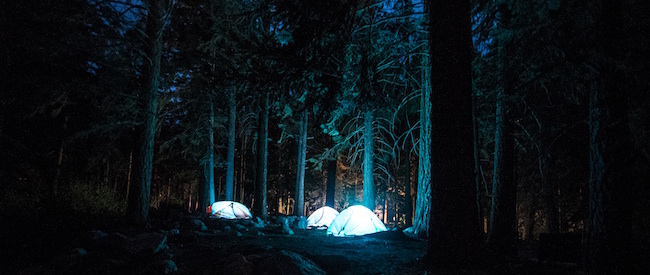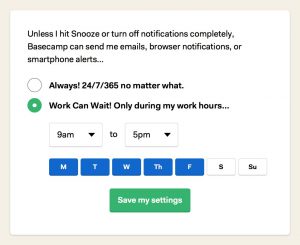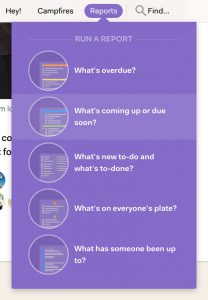
Moving Camp: Our Transition to Basecamp 3
We haven’t been shy about our love of Basecamp.
Basecamp is right up there with Google and Slack as one of the most-used tools at 9 Clouds. It even got its own part of speech (“Basecamp me the preview of that dinosaur graphic,” someone would very possibly say in our office).
But with the introduction of Basecamp 3, we were faced with a hard decision. Basecamp 2 was working just fine — and you don’t fix what’s not broken, right? But the allure of new features was strong. We are millennials, after all.
So we made the decision to pick up our tents and move to Basecamp 3.
2 to 3: Planning the Move
We’d been living in Basecamp 2 for quite a while, so the decision to move was no small task. Especially since Basecamp doesn’t expect customers to pack up and leave one Basecamp for the other. They expect it to be a rent-two-places kind of arrangement.
 That was not going to work for us.
That was not going to work for us.
We use Basecamp as the home for all of our client work: blog drafts, company logos, internal communications, strategy documents, and more. Our small team works with quite a few clients, so that means each individual person is on several projects at once.
If we were going to make the move, it was going to be an all-or-nothing switch.
As of publication, this is the biggest hurdle for anyone who wants to use Basecamp 3. The company does have plans to explore migration options by “mid-2016,” but those haven’t been revealed quite yet.
This meant our team was tasked with a manual migration. We decided it would be best for project managers, the people who assign and organize production, to move the existing projects. We also decided to move only the most vital pieces: existing to-dos, logos, and contracts.
We felt pretty safe moving only high-level documents because Basecamp doesn’t erase your old projects; we relied on Basecamp 2 to exist as an archive. Having both versions to reference was especially important in the first few weeks after the switch.
⌘-V: Manually Migrating
Once we knew manual migration was the only way to go, we sort of stopped talking about Basecamp 3 for a while. No one really wanted to admit that moving hundreds of to-dos was the reality of the situation.
Months (seriously) after the initial conversation opened up, we finally ripped off the Band-Aid and scheduled a weekend for The Migration.
A word of wisdom for anyone considering transitioning from Basecamp 2 to Basecamp 3: just rip it off. You’ll lose a little arm hair, but if you really want to update, it’s much less painful than the alternative, which is operating out of two different Basecamp systems and losing productivity (and probably important files).
The reason we planned for a weekend transition was for our content team’s benefit. Everyone could end their week in Basecamp 2 and start fresh in Basecamp 3 on Monday morning.
I took on The Migration with gusto because I knew it was something our team needed to get done (remember how we talked about it for months?), and apparently, I’m a glutton for punishment (here’s the proof).
Now that I’m done with The Migration, I like to say it was much less painful than ripping off a Band-Aid, but I think I might’ve answered differently halfway through. It took me about 10 hours to copy and paste everything. In our case, that was 573 to-dos across 22 projects.
Learning Basecamp 3
Assigning 573 to-dos makes you a Basecamp 3 Master, but the rest of our team had some learning to do that first Monday in the new system.
The new system is, fortunately, intuitive. Basecamp also offers a course about the new program to answer some of the most frequently asked questions, which we all took advantage of.
Basecamp 3 is more robust than any prior version. Each project (called a lowercase “basecamp” now) starts with six tools: To-dos, Schedule, Automatic Questions, Docs & Files, Campfire, and Message Board.
You can turn these tools on and off as needed.
For instance, we’ve gotten rid of the Campfire on most of our basecamps because it’s essentially a Slack channel built within the system. Our team is really established with our current Slack operation, but if you don’t already use Slack (or another messaging platform), the Campfire would be a great feature to leave on.
Each basecamp is completely customizable to your team’s workflow and the project’s needs.
Trying Basecamp 3’s New Features
Now that the poles are up and we’re fully settled into Basecamp 3, we can really enjoy those new features that pushed us to switch in the first place.
Multiple Assignments
This is, without a doubt, the feature I was waiting for the most. And I think I held this one feature up too high because it’s not really everything I hoped and dreamed.
It’s still pretty cool, though.
In Basecamp 3, you can assign a single to-do to one or seven people. The sky’s the limit. The issue I’ve found (and my other project managers concur) is that when one person marks the task done, it’s completed for everyone on the to-do. That’s not always ideal, but we’ve come up with workarounds that are pretty simple. Considering we had to make individual to-dos for each person in Basecamp 2, this feature still saves time.
You can also assign a to-do for a date range, rather than just a single date. This helps give people a sense of the length of time you expect a project to take. However, important caveat: the due date shows the last date in the range. This means folks who look at their task list day by day won’t actually see a long-term to-do until the very end, which can negate the need for the date range in the first place.
 Work Can Wait
Work Can Wait
It’s 2016, which means it’s damn near impossible to disconnect from your job sometimes.
We really encourage work-life balance at 9 Clouds, and the new “Work Can Wait!” feature on Basecamp 3 helps turn that mindset into a practice. You can snooze notifications when you’re off the clock — no matter what weird hours or days you clock time.
This doesn’t mean our work isn’t important, but it does mean our personal lives get the full attention they deserve. If there’s a true marketing emergency, our team and our clients know a good, old-fashioned phone call is the best course of action.
@Mentions
In the social media age, it seems so natural to type @YourColleague and get their attention. It works on Twitter; it works on Slack; and now, it works on Basecamp.
Whenever you @Mention someone within any basecamp, they’re sent a notification with a link to the place they were mentioned. This person doesn’t have to be assigned the to-do, but you can easily bring them in for input in Basecamp 3.
Applause
Okay, admittedly the applause feature on Basecamp 3 isn’t solving any major productivity issues or cutting down on wasted time. But it’s one of our favorites nonetheless.
You can click the little applause button on any message, comment, document, or file in Basecamp 3. When you do, your coworker gets a discrete ? notification, and your computer makes the Super Mario coin noise.
Basecamp says, “This is a great way to show your support for someone’s suggestion, idea, or point of view without also sending a notification to everyone else on the project.” We’ve found it’s a great way to let someone know you’ve seen their comment, even if you don’t have time to respond ASAP.
 Reporting
Reporting
Finally, reporting in Basecamp 3.
This probably doesn’t mean much to the creatives who work on content every day, but for project managers, it’s a huge change.
We can simply type in What’s [This Dude] been working on? or What did [Employee X] say about [Top Secret Project] the other day? — and there it is.
All the answers project managers want are easily found through this handy reporting tab, which brings together everyone’s messages, comments, to-dos, and to-dones.
This feature gives managers the opportunity to see the big picture of a project more easily than in older versions of Basecamp. We especially appreciate this because we can quickly tell if someone is going to be overextended for the week or if they’ll have extra capacity to help out with unexpected projects.
⛺: Settling In To Basecamp 3
So now that we’re on the other side, would we do it again? Transition from Basecamp 2 to Basecamp 3, manual migration and all?
Heck yes.
Sure, the process took a little time and a lot of colorful language, but Basecamp 3 is an invaluable piece of our business. It truly does make “chaos, organized.”
We take efficiency seriously at 9 Clouds. Follow our blog for more tips and tricks on getting shit done.






